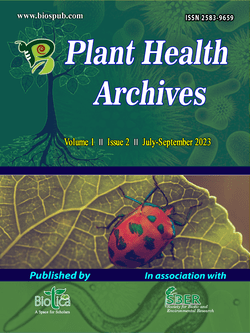
Isolation and Characterization of the Incitant of Leaf Spot of Turmeric and in-vitro Efficacy of Native Isolate of Endophytic Bacteria
Madhusmita Mahanta*
School of Crop Protection, College of Post Graduate Studies in Agricultural Sciences, Central Agricultural University (Imphal), Umiam, Meghalaya (793 103), India
T. Rajesh
School of Crop Protection, College of Post Graduate Studies in Agricultural Sciences, Central Agricultural University (Imphal), Umiam, Meghalaya (793 103), India
Pranab Dutta
School of Crop Protection, College of Post Graduate Studies in Agricultural Sciences, Central Agricultural University (Imphal), Umiam, Meghalaya (793 103), India
DOI: https://doi.org/10.54083/PHA/1.2.2023/29-33
Keywords: Colletotrichum, Curcuma longa L., Endophytes, Leaf spot, Meghalaya, Turmeric
Abstract
Turmeric, Curcuma longa L. is an important commercial spice crop cultivated in Meghalaya covering 2,649 ha area with 16,497 MT productions. However, the turmeric cultivation is severely affected by leaf spot disease limiting its yield. So, the present study was conducted to identify the pathogen associated with leaf spot disease of turmeric as well as to check the efficiency of bacterial endophytes in managing the disease. Based on the morphological and cultural studies, six isolates of Colletotrichum gloeosporioides were identified as the causal organism of leaf spot disease of turmeric. The isolates on PDA medium produced white to grey fluffy (raised/ flat) cottony culture with serrated margin. All the isolates produced dark brown acervuli and globular conidia with oil globules inside. Five bacterial endophytes viz., BE 1, BE 222, M1W1, NGB21 and SVC 11 were tested against C. gloeosporioides by using dual culture assay. They were able to inhibit the mycelial growth of C. gloeosporioides in the range of 35.82-68.11%. The highest percent inhibition in dual culture assay was recorded in the isolate NGB 21 (68.11%) followed by isolate BE1 (59.89%).
Downloads
not found
Reference
Adhipathi, P., Nakkeeran, S., Chandrasekaran, A., 2013. Morphological characterization and molecular phylogeny of Colletotrichum capsici causing leaf spot disease of turmeric. The Bioscan 8(1), 331-337.
Akhter, M.S., Alam, S., Islam, M.S., Lee, M.W., 2009. Identification of the fungal pathogen that causes strawberry anthracnose in Bangladesh and evaluation of in vitro fungicide activity. Mycobiology 37(2), 77-81. DOI: 10.4489/MYCO.2009.37.2.077.
Ann, Y.C., Sallehin, A.A., Roslan, H.A., Hussain, M.H., Lihan, S., 2015. Antagonistic activity of endophytic Bacillus species against Colletotrichum gloeosporioides for the control of anthracnose disease in black pepper (Piper nigrum L.). Global Journal of Biology Agriculture & Health Sciences 4(2), 115-123.
Anonymous, 2019. Handbook on area, production and yield of principal crops in Meghalaya, 2019 (Including land use statistics and Irrigation Statistics). Available at: http://www.megplanning.gov.in/statistics/Area%20Production%20and%20Yield%20of%20Principal%20Crops%202019.pdf. Accessed on: 15th November, 2021.
Chawda, S.K., Sabalpara, A.N., Pandya, J.R., 2012. Epidemiology of turmeric (Curcuma longa L.) leaf spot Colletotrichum gloeosporioides (Penz. and Sacc.). The Bioscan 7(2), 441-443.
Dennis, C., Webster, J., 1971. Antagonistic properties of specific groups of Trichoderma: Production of volatile antibiotics. Transactions of the British Mycological Society 57, 41-48. DOI: 10.1016/S0007-1536(71)80078-5.
Dev, D., Somasekhara, Y., Prasannakumar, M., 2017. Cultural characterization of Colletotrichum gloeosporioides causing anthracnose of pomegranate. Indian Phytopathology 70(4), 493-495.
Gautam, A.K., 2014. Colletotrichum gloeosporioides: biology, pathogenicity and management in India. Journal of Plant Physiology & Pathology 2, 2-9.
Hudge, B.V., Ghugul, S.A., 2010. Losses in yield and quality of turmeric due to leaf spot disease caused by Colletotrichum capsici. International Journal of Agricultural Science 6(1), 43-45.
McRae, W., 1917. Notes on some South Indian Fungi. Madras Agricultural Yearbook. pp. 108-111.
Papade, V.V., Potdukhe, S.R., Navsupe, D.R., Guldekar, D.D., Taral, A.L., 2019. Morphological characters of Colletotrichum gloeosporioides from various hosts. International Journal of Chemical Studies 7(4), 75-78.
Patel, R.V., Joshi, K.R., Solanky, K.U., Sabalpara, A.N., 2005. Colletotrichum gloeosporioides: A new leaf spot pathogen of turmeric in Gujarat. Indian Phytopathology 58(1), 125.
Prabakar, K., Raguchander, T., Parthiban, V.K, Muthulakshmi, P., Prakasam, V., 2005. Post-harvest fungal spoilage in mango at different levels of marketing. Madras Agricultural Journal 92, 42-48.
Pruthi, J.S., 1976. Spices and condiments. National Book Trust, New Delhi. pp. 223-227.
Rao, T.N., Reddy, B.N., Sasikumar, B., 1993. Production constraints of turmeric in Andhra Pradesh. Spice India 6, 8-13.
Senapoty, D., Das, G., Dutta, S., Dutta, P., 2019. Management of fruit rot of “Bhut Jolokia” (Capsicum chinense Jacq.) caused by Colletotrichum gloeosporioides with biological approaches. Bulletin of Environment, Pharmacology and Life Sciences 9(1), 78-84.
Shahbandeh, M., 2020. Leading global exporting countries of turmeric 2019. Available at: https://www.statista.com/statistics/798287/main-turmeric-export-countries-worldwide/. Accessed on: 26th June, 2022.
Sharma, B., 2019. Incidence of postharvest fruit rot of chilli (Capsicum annum L.) and its management in Meghalaya. M.Sc. (Agri.) Thesis, Central Agricultural University (Imphal), Manipur. p. 32.
Tasiwal, V., Benagi, V.I., Hegde, Y.R., Kamanna, B.C., Naik, K.R., 2009. In vitro evaluation of botanicals, bioagents and fungicides against anthracnose of papaya caused by Colletotrichum gloeosporioides (Penz.) Penz. & Sacc. Karnataka Journal of Agricultural Science 22(4), 803-806.
Than, P.P., Jeewon, R., Hyde, K.D., Pongsupasamit, S., Mongkolporn, O., Taylor, P.W.J., 2008. Characterization and pathogenicity of Colletotrichum species associated with anthracnose on chilli (Capsicum spp.) in Thailand. Plant Pathology 57(3), 562-572. DOI: 10.1111/j.1365-3059.2007.01782.x.
Vincent, J.M., 1947. Distortion of fungal hyphae in the presence of certain inhibitors. Nature 159, 850. DOI: 10.1038/159850b0.
Wang, Q.H., Fan, K., Li, D.W., Han, C.M., Qu, Y.Y., Qi, Y.K., Wu, X.Q., 2020. Identification, virulence and fungicide sensitivity of Colletotrichum gloeosporioides responsible for walnut anthracnose disease in China. Plant Disease 104(5), 1358-1368. DOI: 10.1094/PDIS-12-19-2569-RE.
